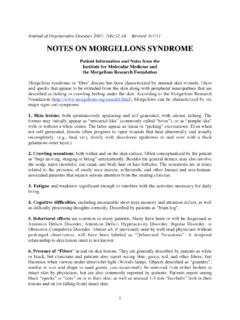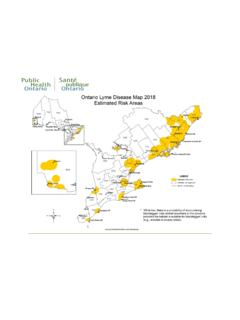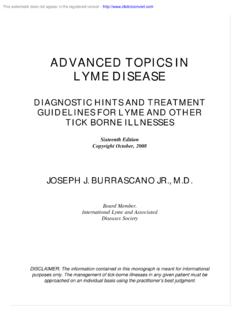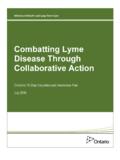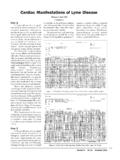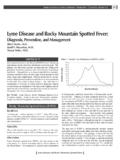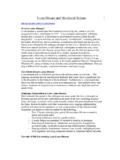Transcription of Mycoplasma – Often Overlooked In Chronic Lyme Disease
1 1 Mycoplasma Often Overlooked In Chronic lyme Disease Public Health Alert, v. 4, no. 7, 2009 Mycoplasma Often Overlooked In Chronic lyme Disease n by Scott Forsgre Those of us with Chronic lyme Disease are quite familiar with the names of the better known lyme co infections. Babesia, Bartonella, and Ehrlichia have become everyday words. As much as we would like to rid ourselves of these illness producing pathogens, they have become a part of our daily struggle to regain a sense of health and wellness. Unfortunately, these are not the only co infections seen in Chronic lyme Disease . For some reason, Mycoplasma infections are not only lesser known by patients, but seemingly Often Overlooked by doctors as well. It is important for us, as patients, to educate ourselves on the topic of Mycoplasma and ask our practitioners how we are being evaluated and totreated for these infections. In 1987, Dr. Garth Nicolson, PhD was a professor at the University of Texas at Houston when his wife, an instructor at Baylor College of Medicine, became seriously ill and nearly died.
2 She was diagnosed with a Mycoplasma infection, treated, and later recovered. A few years later, their daughter, who ad served in the Gulf War, returned from active duty quite ill. Not only was she sick, but the symptoms that hshe exhibited were very similar to those that Dr. Nicolson s wife had expressed years earlier. At that point, Dr. Nicolson had the idea that his daughter s illness could be the result of an infection and started to investigate his theory further. As his work progressed, he looked at Brucella, Borrelia, Ehrlichia, and other Chronic intracellular infections that have the potential to cause illness and present with overlapping signs and symptoms. In Gulf War veterans that were being evaluated, approximately 45% of hose that were ill had Mycoplasma infection. It was found that the infection was a particular type of sma fermenttMycoplasma, namely a peculiar species called Mycoplaans. Very little was known about this particular species of Mycoplasma at the time except that the Armed Forces Institute of Pathology and the Army had been doing research on the organism.
3 Once this likely causative agent of Gulf War Illness (GWI) had been identified in about one half of the GWI cases, Dr. Nicolson recommended that the Mycoplasma infected Gulf War veterans be treated with Doxycycline. He then found himself the target of viscous attacks for making the connection between the illness and M. fermentans. Dr. Nicolson shared that even talking about this organism was highly discouraged. In fact, until the Gulf War, the military s own medical school had been teaching about the dangers of M. fermentans for years. Background Just years earlier in Texas, prisons emerged in which many of the inmates and guards came down with neurodegenerative conditions at rates that were far from ordinary. In Huntsville, where three large State prisons are found, there were about 70 cases of ALS, numerous cases of Multiple Sclerosis, and highly nexpected numbers of Rheumatoid Arthritis cases. At that time, the term Mystery Disease was used to uidentify the unusual illnesses that so many seemed to have acquired.
4 Dr. Nicolson started testing prison guards and their family members and found that very high numbers of these people were testing positive for Mycoplasma fermentans. Furthermore, this appeared to be a weaponized version of the organism called M. fermentans incognitus, a specific strain of Mycoplasma that had 2 Mycoplasma Often Overlooked In Chronic lyme Disease been altered to cause more severe symptoms, to be more virulent, and to be more survivable than the aturally occurring M. fermentans. Dr. Nicolson believed that biological weapons experiments had been pigs. ncarried out on inmates in the Texas prison system for years in which humans had been used as guinea As time progressed, these illnesses did not remain confined to the prisoners. Soon after the prisoners unknowingly became a part in these experiments, the prison guards became ill. Their illnesses gradually ecame those of their families. It was not long before these Mycoplasma based illnesses became a broader bpart of the surrounding Huntsville, Texas landscape.
5 The Texas prisoners that came down with Amyotrophic Lateral Sclerosis (ALS) later died. In the state of Texas at the time, the state law dictated that all prisoners that died were later to be autopsied at University of Texas at Galveston. However, that was not what was happening to the prisoners who had died as a result of this horrific experimentation according to Dr. Nicolson. Through one of his former students who at the time was responsible for the autopsy service at UT Galveston, Dr. Nicolson learned that none of the bodies had been sent there. Dr. Nicolson had discovered that at least six private autopsies a week were being performed on deceased prisoners at a US Army base. The bodies were then sent to a private crematory at a secret ocation in central Texas. Additionally, prisoner records were destroyed. All of this, according to Dr. lNicolson, violated state law. Though much of the evidence of this experimentation had been destroyed, a document was found in the basement of an Austin building that was viewed as the smoking gun.
6 The document indicated that the Texas Prison Board, Baylor College of Medicine, and the Department of Defense were all a part of the experiments involving the Texas prisoners experiments that later resulted in the death of many of the inmates. According to Dr. Nicolson, some of the experiments used Mycoplasma while others utilized various cocktails of microbial agents such as Mycoplasma , Brucella, and DNA viruses such as Parvovirus B19. This pic of a book by Dr. Nicolsonproject later become the to entitled Project Day Lily. Dr. Nicolson believes that Mycoplasma fermentans is a naturally occurring microbe. However, some of the strains that exist today have been weaponized. Dr. Nicolson s research found unusual genes in M. fermentans incognitus that were consistent with a weaponized form of the organism. Weaponzing of an organism is done in an attempt to make a germ more pathogenic, immunosuppressive, resistant to heat and dryness, and to increase its survival rate such that the germ could be used in various types of weapons.
7 Genes which were part of the HIV 1 envelope gene were found in these Mycoplasma . This means that the infection may not give someone HIV, but that it may result in some of the debilitating symptoms of the HIV Disease . Indicators of a weaponized organism were evident in the prison guards in Huntsville as well as in military personnel that were likely exposed to the infections both through military vaccinations as well as through weapons used in the Gulf War. The unfortunate reality according to Dr. Nicolson is that once these things get out, you can t put the genie back in the bottle . Once these germs have been released, they are airborne infections that slowly penetrate into the population. In the case of Mycoplasma fermentans, Dr. Nicolson believes that this is exactly what happened. It may be this weaponized form of Mycoplasma that has led to the significant increases in neurodegenerative and autoimmune diseases over the last several years.
8 Those patients with weaponized trains of these organisms are generally very sick. They may experience 60 75 signs and symptoms and are seven at risk of their diseases becoming fatal. In looking at the source of infection in the Gulf War veterans who were contracting Mycoplasma , Dr. Nicolson suggests that vaccinations appear to be the most likely mechanism through which the veterans became infected. Many military personnel that later became ill were far from the battlefields or had received the vaccinations and were never deployed. However, biological weapons sprayers were known to have been deployed by the Iraqis in the Gulf War and were used to spray the sand in Iraq and Kuwait. Gerald Mycoplasma is the number one coinfection observed in lyme Disease patients 3 Mycoplasma Often Overlooked In Chronic lyme DiseaseSchumacher, a Special Forces colonel in charge of biological weapons detection, blew the whistle on this after e retired. During the Gulf War, his group was not allowed to deploy their biological weapons detectors hwhich led to reports that no such weapons were detected or used.
9 The Iraqis received a great deal of assistance on biological warfare from the United States during the Iran Iraq Conflict. Both chemical and biologic weapons were given to them from the United States. After the Gulf War, rather than taking inventory of these weapons, they were blown up. Dr. Nicolson indicates that some of his patients have taken videos standing next to crates with Hazardous Materials tags from the United States. n the same videos, the crates are opened and weapons are clearly striped as having originated from the IUnited States and being both chemical and biological weapons. There were clear indicators that Iraq had offensive weapons in their arsenal. In Kuwait, many people had become quite ill. It was estimated that 25% of the population after the Gulf War had signs and symptoms which matched the symptoms of those infected with weaponized Mycoplasma . There were also a number of ther chemical exposures and thus, there was never a clear indicator as to whether or not the Iraqi illnesses owere caused by biologic or chemical agents.
10 When asking Dr. Nicolson how much he personally has been harassed for bringing much of this information to light, he shared that it has been a horrific time . After Dr. Nicolson exposed the Huntsville prison experiments, the University of Texas educational system attempted to fire him from his tenured and highly respected position. Dr. Nicolson shared that a tremendous amount of pressure was put on the University of Texas system to shut him up and close his laboratory . He was threatened on an almost daily basis with closing his lab as he continued to do his research on Mycoplasma . This became a major subject in the book Project Day Lily. Fortunately, for many of us struggling with Chronic illnesses, Dr. Nicolson s experience and knowledge continue to be a benefit in that we understand so much more than we otherwise would about this formidable foe called Mycoplasma . Symptoms The signs and symptoms of Mycoplasma infection are highly variable and thus it is not uncommon for a diagnosis to be entirely missed.

